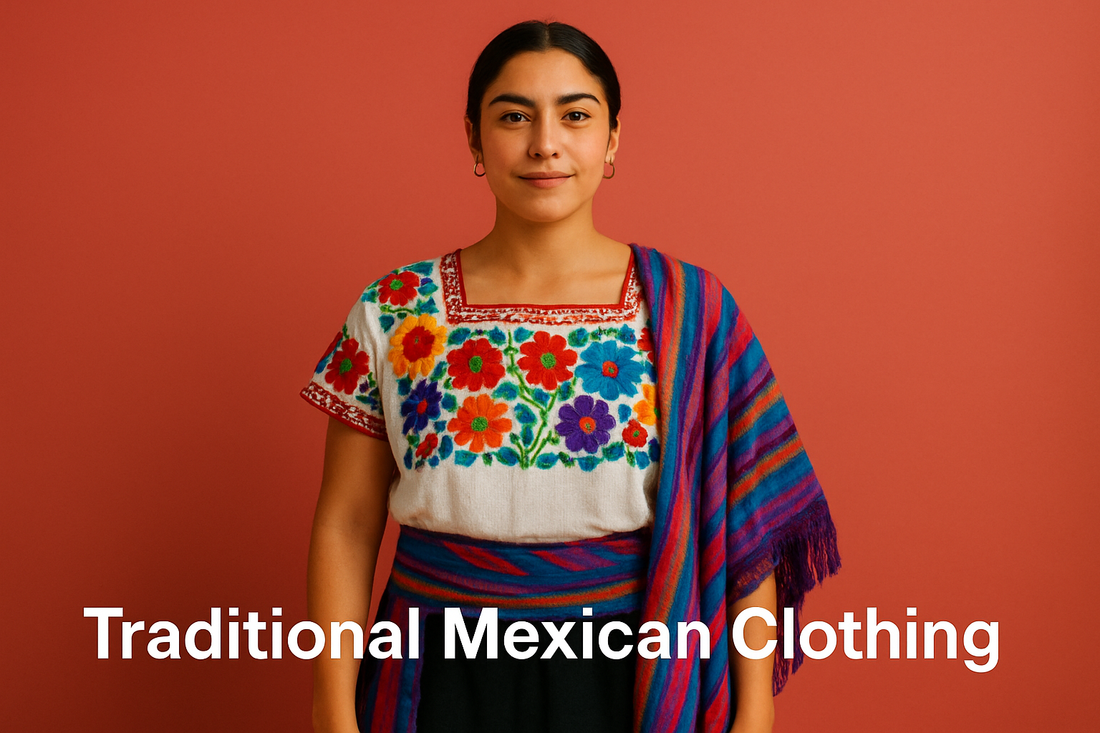
Traditional Mexican Clothing: History, Styles, and Meaning
Share
Traditional Mexican clothing is a direct expression of Mexico’s deep cultural roots, shaped by centuries of Indigenous traditions and Spanish influence. These garments are known for their vivid colors, intricate embroidery, and symbolic patterns that carry meaning far beyond aesthetics. Worn by different communities across the country, traditional Mexican clothing reflects a deep respect for heritage and identity. From ceremonial outfits to everyday garments, these clothes serve not just as attire but as a visual language, telling stories of regional customs, family lineage, and local artistry.
In modern Mexico, traditional clothing remains an important part of cultural events, national holidays, weddings, and religious celebrations. During festivals like Día de la Independencia or Guelaguetza in Oaxaca, people proudly wear these garments to celebrate and honor their heritage. Even beyond special occasions, elements of traditional dress have found a place in contemporary fashion, showing that these styles continue to evolve while staying true to their roots. Ready to honor our heritage with pride? Explore traditional pieces made with corazón and cultura crafted to be worn with purpose.
Read also: Traditional Mexican Outfits: History, Styles, and Cultural Significance
The History of Traditional Mexican Clothing
Traditional Mexican clothing has a long history that begins with the Indigenous peoples of Mesoamerica. Long before the Spanish arrived, groups like the Aztecs, Mayans, Zapotecs, and Mixtecs created clothing from natural fibers like cotton, agave, and bark. These garments were often handmade and decorated with patterns that held spiritual or social meaning. Styles varied by region, but shared a deep connection to nature, community, and ceremony.
The Spanish conquest in the 16th century introduced European fabrics, tailoring techniques, and religious dress codes. This led to a fusion of Indigenous and colonial fashion, giving rise to many of the traditional garments we recognize today. Embroidery became more elaborate, and materials like wool and silk were added to local textiles. Despite colonization, many Indigenous communities preserved their clothing styles as a form of cultural resistance and pride.
Over time, traditional clothing became a symbol of national identity. In the modern era, these garments serve both as cultural heritage and inspiration for contemporary Mexican fashion.
Common Traditional Mexican Garments
Huipil
A huipil is a loose-fitting tunic traditionally worn by Indigenous women across Mexico. Made from cotton or wool, it’s often handwoven on a backstrap loom and decorated with embroidery that tells stories about the wearer’s village, beliefs, or social role. Huipiles are still worn today, especially in southern Mexico.
Rebozo
The rebozo is a rectangular shawl used by women for warmth, modesty, or carrying children. It’s often woven with intricate patterns and can range from simple cotton to luxurious silk. It represents femininity and practicality and is still widely used in daily life and ceremonial events.
Sarape
The sarape (or serape) is a colorful, blanket-like shawl worn by men, especially in central and northern Mexico. Typically made of wool, it features bold stripes and geometric patterns. It’s commonly seen at fiestas and folkloric dances.
Sombrero
Sombreros are wide-brimmed hats designed to protect from the sun, especially in rural and farming regions. Traditionally made from straw or felt, sombreros also became iconic through mariachi and charro culture.
Charro Suit
Originating from Jalisco, the charro suit is a formal outfit worn by mariachi musicians and horse riders. It includes tight-fitting pants, a short jacket, embroidered detailing, and is often paired with a sombrero. It symbolizes pride, elegance, and national identity.
China Poblana Dress
The China Poblana is a colorful dress that features a sequined blouse and full, embroidered skirt. It’s often associated with Puebla and has become a national symbol of traditional Mexican femininity.
Quechquemitl
This is a poncho-like garment worn by Indigenous women in central and southern Mexico. Formed by joining two rectangles of fabric, it’s often richly embroidered with floral or symbolic designs and used in both daily and ceremonial wear.
Regional Styles of Traditional Mexican Clothing
Traditional Mexican clothing is not one-size-fits-all. Different states and regions in Mexico have developed their own clothing styles over generations, each reflecting local customs, environments, and cultural roots. These differences can be seen in the fabrics, embroidery patterns, and garment shapes. What someone wears in Oaxaca might look completely different from the styles seen in Jalisco or Veracruz. This diversity is one of the reasons traditional clothing in Mexico is so visually rich and culturally meaningful.
Here are a few standout regional styles:
-
Oaxaca: Bold colors, dense embroidery, and layered garments are common. Many communities still use backstrap looms to create detailed patterns passed down through generations.
-
Chiapas: Known for floral motifs, bright threadwork, and textured handmade fabrics, especially among Tzotzil and Tzeltal communities.
-
Jalisco: The birthplace of the charro suit and mariachi style, this region features formal outfits with detailed silver embroidery and fitted silhouettes.
-
Veracruz: Jarocho clothing is typically white and made from lightweight cotton. Women’s outfits often include lace and ribbons, while men wear guayaberas and straw hats.
-
Yucatán: Home to elegant huipiles with fine, hand-stitched floral embroidery, usually worn with lace slips and accessories like gold filigree jewelry.
Regional styles are more than fashion, they reflect each area's unique cultural story. Local designs often tell you about the community’s traditions, social roles, and relationship with the land. Wearing these garments is a way to carry on heritage and express identity through fabric and craftsmanship. At Ay Pero Que Cute, we honor these traditions by offering authentic, culturally rooted pieces you can wear with orgullo—explore our collection and bring your heritage to life.
Fabrics and Textiles in Traditional Mexican Clothing
The materials used in traditional Mexican clothing are carefully chosen, often based on what’s locally available and suited to the climate. Cotton is one of the most widely used fabrics across Mexico. It’s breathable, durable, and easy to dye, which makes it ideal for both everyday wear and special garments. Wool is used in colder regions or for shawls and sarapes, offering warmth and structure. In some regions, silk is used for more formal or ceremonial pieces, especially in decorative sashes or detailed embroidery.
Techniques like weaving, hand embroidery, dyeing, and beadwork are central to the production of these garments. Weaving is often done on backstrap or pedal looms, allowing artisans to control every detail of the textile’s pattern. Embroidery is more than decoration, it often represents religious beliefs, natural elements, or family heritage. Dyeing with natural pigments is also traditional in many regions, using plants, insects, or minerals to achieve vibrant colors. Beadwork and metallic threads are added to garments in some areas to highlight specific designs or spiritual symbols.
These textiles aren’t just fabric, they carry meaning. In many Indigenous communities, the designs woven into garments can reflect the wearer’s status, marital situation, or region of origin. This deep symbolism is what makes Mexican textiles and traditional Mexican fabrics such an essential part of cultural storytelling.
Accessories That Complete Traditional Mexican Clothing
Traditional Mexican clothing is rarely complete without accessories. These pieces are not just decorative, they serve practical purposes and carry cultural meaning. Here are some of the most important accessories commonly worn with traditional outfits:
-
Huaraches (sandals): These are handmade leather or woven sandals known for comfort and durability. In some areas, they’re decorated with colorful beads or stitching.
-
Belts and sashes: Often woven or embroidered, belts and sashes help hold garments in place and add visual interest. They can also show status or regional identity.
-
Jewelry: Traditional Mexican jewelry includes silver and gold pieces, often featuring motifs like flowers, birds, or religious symbols. Filigree techniques and handcrafting are still used in many parts of Mexico.
-
Rebozos as accessories: Rebozos serve many functions beyond clothing. They’re used as shawls, baby carriers, head wraps, and even ceremonial coverings. Some women use them daily, while others wear them during religious or cultural events.
Each accessory contributes to the complete look of traditional Mexican clothing, enhancing both its beauty and cultural importance. These items connect generations and show how style and symbolism go hand in hand.
Traditional Clothing in Modern Mexico
Traditional Mexican clothing is still a visible and respected part of modern life in Mexico. These garments are proudly worn during national holidays like Independence Day and Día de la Revolución, as well as at religious festivals, folkloric dances, and cultural parades. During weddings, especially in rural areas or among Indigenous communities, it's common to see brides or guests in embroidered huipiles or regional dresses that reflect family or community traditions. These moments keep traditional clothing relevant, not just as historical symbols, but as active parts of people’s identities.
Younger generations are also playing a role in keeping these styles alive. Mexican fashion designers are now blending traditional garments with contemporary cuts and fabrics, creating looks that are both modern and deeply rooted in cultural pride. Many use huipil-inspired silhouettes or rebozo textiles in runway fashion or everyday streetwear. This merging of old and new speaks to a growing appreciation for authenticity and originality in style.
Sustainability has also pushed traditional clothing back into the spotlight. Artisan-made garments, woven with care and intention, are being valued more than mass-produced fast fashion. Consumers are starting to understand that modern Mexican clothing isn’t about copying trends, it’s about honoring culture while embracing ethical fashion choices. This shift is helping traditional artisans gain recognition and economic support, ensuring these garments remain part of Mexican fashion culture for generations to come.
How to Respect and Support Traditional Mexican Clothing
Buying or wearing traditional garments comes with a responsibility to respect the culture and the people behind them. If you’re looking for where to buy authentic traditional Mexican clothing, here are the best ways to do it with care and awareness:
-
Buy directly from artisans and cooperatives
Purchasing from local weavers, Indigenous communities, or artisan markets ensures that your money goes straight to the makers. This supports traditional craft and keeps the knowledge alive. -
Learn the story of each garment before wearing it
Understand the meaning, origin, and cultural value of what you're wearing. This helps you avoid using sacred or ceremonial garments in the wrong context. -
Avoid mass-produced imitations
Factory-made “traditional” clothes often copy designs without giving credit or support to the original creators. Choose handmade, not machine-made, whenever possible. -
Support brands that work with Indigenous communities
Look for fashion labels or boutiques that collaborate directly with weavers and artisans. Ethical brands often share the background of each piece and pay fair wages.
Being mindful about how you buy and wear traditional Mexican clothing shows respect. It also helps protect the communities and cultures that have preserved these designs for generations.
Conclusion: The Lasting Importance of Traditional Mexican Clothing
Traditional Mexican clothing is more than fabric and thread, it’s a living expression of history, culture, and personal identity. These garments carry stories from generation to generation, showing how fashion can hold deeper meaning when it’s rooted in tradition. From embroidered huipiles to the formal charro suit, every piece reflects the creativity, pride, and values of the people who wear them.
As modern Mexican clothing continues to evolve, we’re seeing a powerful blend of heritage and innovation. Young designers, local artisans, and conscious consumers are bringing traditional styles into the future without losing their cultural soul. That’s what makes these garments so important, they're not just part of the past; they’re still shaping the present.
Whether you’re exploring your own roots or discovering a new cultural tradition, appreciating and supporting authentic traditional Mexican clothing is a meaningful way to stay connected to one of the world’s most vibrant and diverse fashion cultures. Ay Pero Que Cute isn’t just fashion, it’s our culture in every stitch. Discover the story behind our roots and wear it with orgullo.
